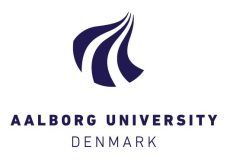Chunfang Zhou is Associate Professor in Department of Planning at Aalborg University (AAU). Ten years ago, she came to Denmark on a PhD scholarship to study ‘Group Creativity Development in Problem and Project-Based Learning Environment in Engineering Education’. Her research is cross-cultural comparing young engineers and technology designers’ creativity in China and Denmark. One of the questions is how humour is interplayed with creativity in design processes and group work in different cultures.
Chunfang Zhou advances research on creativity in particular contexts of technology and engineering within a broader area of Science, Technology, and Society (STS) at Aalborg University. At the same time, she interacts with faculty at her home university Northeastern University (NEU) in Shenyang, Liaoning, China, and serves as the coordinator of overall collaboration between the two institutions.
I meet Chunfang Zhou in one of the new buildings of Aalborg University, right on the waterfront of Aalborg Harbour. Her personal journey with Problem Based Learning (PBL) prompts my first question:
How to overcome cultural challenges to PBL?
– There are some cultural barriers. China is currently changing from ‘Made in China’ to ‘Created in China’, so governments encourage creativity and innovation very much. I am very happy that this autumn, I am going to be a research project coordinator inviting one group of teaching staff from NEU to visit AAU. We will design, participate, and facilitate changes towards Problem and Project-based learning together. To change any case of educational paradigm, the basic thing is that we change people’s language, but language is not only about speaking language, it means ways of thinking, ways of behaviour, it means the foundation of the values. We need to let people have some experience of the real PBL environment, then they know what they can learn from the experience. It is not only to learn new knowledge and skills of a new educational model, but also about to learn a new learning culture. Participants are expected to re-shape or co-construct the new learning culture when they go back to their home countries.
– During my stay in Denmark, I have met a lot of researchers and students who stayed here for a short visit and then went back to their different countries again. Among some of them, we still keep in touch. I think their values have been changed somehow. They now play a leading role in their context. But I never believe one educational model can be fully copied from one culture to another one. For example, in China, we must work with a Chinese PBL model to fit Chinese culture. There are efforts to redesign the whole university system, including the curriculum and a training program for teaching staff. There are also efforts for primary school. It will be very weird for Chinese students, if they follow a traditional, lecture-centered, educational model from primary school to high school and then suddenly meet PBL in the university. They don’t know how to organise group work, they don’t know how to involve themselves in group discussion. Because in their previous education they learnt how to listen and memorize. We need a comprehensive effort and an overall framework for the whole educational system. It sounds like a very ambitious plan, but we need to do it step by step. We are happy to see today, educational reforms are in the making in China, which has called for a student-centred learning, learning by doing, and creative teaching and learning, etc. New educational philosophies are being applied into practice. We may see the challenges, but we also can see the potentials and opportunities of going to be better.
How do you maintain a relationship with colleagues in China?
– For me as a Chinese person working in Denmark with creativity and technology innovation in our department, I am enjoying in contributing to international networking. For both parties, they need a bridge, a translator, between the two cultures. As I have been here ten years, I learned two cultural languages, so I may help to negotiate and set up collaboration between the two cultures.
– My latest research project was funded by the Danish Council for Independent Research for three years 2013-16. It was a comparative study on creativity among young engineers in China and Denmark. I am interested in comparison, because comparative studies can set up a mirror so that we can see each other, what are the similarities, what are the differences, and what we can learn from each other between the cultures. Then, the research results help to exchange knowledge and build up new strategies and new research projects together. So, I benefited a lot from the project, ‘Fostering Creativity in Higher Education: A Comparative Study on Pedagogical Strategies of Learning by Projects between Denmark and China’, especially in bringing the networks and communities on the themes of creativity and innovation in the two cultures together.
– Professors working on areas of Science and Technology Studies (STS) were my important collaborative partners in China, like in the latest project, data collection was conducted among young engineers at Northeastern University (NEU); it is my home university where I know professors working on STS. Meanwhile, from collaboration in this project, I became a coordinator of the overeas talent programme of Benbu government, Anhui Province, China. So I am also bridging the collaborative interests on technology design, green knowledge production, user-driven innovation and social innovation, etc.
How did you come upon the idea to focus on different perceptions of humour?
– That is due to my interest in creativity. It could relate to personality, to a kind of process, to a kind of project, it could relate to a lot of things. I noticed humour – also due to my own experience – when I just arrived here and joined a group discussion and had some misunderstanding about Danish culture, especially about humour. Suddenly, people in the group began to laugh, I did not know why. In my mind, Danish humour has its own language, which is different from the Chinese culture. I just kept this in mind. Then, I found a relationship between emotional culture and creativity.
– I introduced this topic into my comparative project. I began to interview both sides, engineering design students here and in my home university. I asked them some questions about what they think about humour in the group work. I was very curious about what happened with humour, the group atmosphere and creativity. Then I interviewed some Chinese engineers, because in my mind the group work in China is more serious than in Denmark. I want to know when humour is allowed and what they think about that.
Looking at the phenomenon of creativity, what is your perception of dimensions going into creativity?
– I locate creativity within a sociological approach. The basic definition of creativity is to provide some new ideas. It is a very classical definition. In the beginning, a concept was defined purely from a psychological approach. It is not enough. My way is to adopt a socio-cultural perspective; in the creative process it is a social constructive process. We want to find the potential of humour. I also located my study within Science and Technology Studies (STS) and I developed a model for creativity in an organisational learning environment.
Do you think humour is an indicator of creativity? Humour can also introduce a lack of discipline in a group.
– In my article A Comparative Study of Student’s Perceptions of Humour in Learning Creative Design Between China and Denmark (2015) I mention that we need creatively to use humour in group work. If people are very humorous, he or she can always use a new way. Humour itself is a kind of creativity. We need to think about how to use humour. Otherwise, it will become loose. It could be a kind of glue between people, a way to build a relationship and to relieve emotion and get relaxed. It is good for group work. But humour should be healthy and beneficial for the group atmosphere and the emotions of the individual.
What is your next step in research?
– I benefitted a lot from my independent research project. So the plan is to focus on collaboration between the two cultures. If we can have more funding to build connections, that will be very useful. I can see some calls, in natural science and engineering, with limitations in these calls in other areas. I think we need more focus on technology planning and innovation with relevance to society and culture. Bringing in social sciences, humanities, and cultural studies will broaden the scope. This will benefit a lot for the collaboration, creativity and technology.
The next day evening Chunfang Zhou elaborated her views during the DDRN seminar Mutual South-North learning? Taking stock of development studies at Aalborg University.
CHUNFANG ZHOU’S PHD DEFENCE 11 DEC 2012
Recent research projects
2018-: Project Manager, Participation of Designing Problem-Based Learning (PBL) for Improvement of IT Education in China, Funded by Northeastern University, China.
2017-: Project Manager, Bringing Values of Creativity and Advanced Design Methods to Technology Innovation in China, Bengbu Government, The State Administration of Foreign Experts Affairs (SAFEA), Anhui Province, China.
2015-2017: Project Manager, A Cross-cultural Perspective to Creative Design, Knowledge Management and Organizational Innovation between China and Denmark. Funded by Post Spring Industry Design Institute, China.
2013- 2016: Project Manager, The Danish Council for Independent Research Project “Fostering Creativity in Higher Education: A Comparative Study on Pedagogical Strategies of Learning by Projects between Denmark and China”, funded by Ministry for Science, Innovation and Higher Education (FKK), Denmark.
2008 – 2012: PhD project “Group Creativity Development in Engineering Education in a Problem and Project-Based Learning (PBL) Environment”, Department of Planning, Aalborg.
Recent publications
BOOK SERIES EDITING
Chemi, T., Zhou, C., and Mitra, A. M. (2018) Arts, Creativities, and Learning Environments in Global Perspective. Brill/Sense Publisher.
BOOKS (IN WORKING PROCESS)
Zhou, C. Engineering Creativity and Interacting Minds in Problem-Based Learning, publishing agreement signed with Springer, to be published in 2018.
Zhou, C. Design Creativity Project-Based Learning in Organizations, publishing agreement signed with IGI Global, to be published in 2019.
Zhou, C. Understanding Creativity among Young Chinese Engineers, publishing agreement to be signed with Sense Publisher, to be published in 2019.
BOOKS (PUBLISHED)
Zhou, C. (2016) Handbook of Research on Creative Problem-Solving Skill Development in Higher Education, IGI Global.
Chemi, T., & Zhou, C. (2016). Teaching Creatively in Higher Education: Bridging Theory and Practice. Aalborg Universitetsforlag.
Li, J., Luo, L., and Zhou, C., (2013), Translated book Technology and Creativity (Dasgupta, S., 1996, New York: Oxford University Press) into Chinese. Shenyang: Liaoning People’s Publishing House.
JOURNAL ARTICLES
Zhou, C. (2018). A Study on Creative Climate in Project-Organized Groups (POGs) in China and Implications for Sustainable Pedagogy. Sustainability, 10(114), 1-15.
Chen, H. Tao, T. and Zhou, C. (2018). A Three-Dimension Analysis of Fostering Creative Engineers in China. International Journal of Engineering Education, 34 (2A), 1-11. (In Press).
Wei, C., Sun, X., Liu, J., Zhou, C., & Xue, G. (2017). High Power Distance Enhances Employees’ Preference for Likable Managers: A Resource Dependency Perspective. Frontiers in Psychology, 7, 1-14. DOI: 10.3389/fpsyg.2016.02066
Fabià, G. R., Zhou, C., & Llach, M. C. (2017). Creativity in Biomedical Education: Senior Teaching and Research Staff’s Conceptualization and Implications for Pedagogy Development. International Journal of Engineering Education, 33, (1A), 30-43.
Read more about Chunfang Zhou’s research profile at Aalborg University




